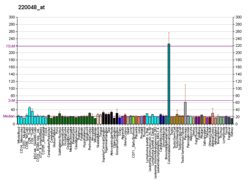Ectodysplasin A receptor
Ectodysplasin A receptor (EDAR) is a protein that in humans is encoded by the EDAR gene. EDAR is a cell surface receptor for ectodysplasin A which plays an important role in the development of ectodermal tissues such as the skin. It is structurally related to members of the TNF receptor superfamily.
EDAR and other genes provide instructions for making proteins that work together during embryonic development. These proteins form part of a signaling pathway that is critical for the interaction between two cell layers, the ectoderm and the mesoderm. In the early embryo, these cell layers form the basis for many of the body's organs and tissues. Ectoderm-mesoderm interactions are essential for the proper formation of several structures that arise from the ectoderm, including the skin, hair, nails, teeth, and sweat glands.
...
Wikipedia





